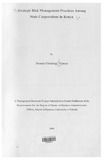| dc.description.abstract | Public entities, including state corporations, are today under more pressure than ever to manage costs and deliver services more efficiently. As operating budgets are scrutinized, public officials search for creative means of cutting costs, maximizing the productivity of existing staff, and working smarter to serve the public’s interests. In order to fulfil their purpose, many public organizations have crafted strategies to guide them in the competitive environments in which they operate. Pursuing such strategies comes with risk. This risk is occasioned by the fact the strategies are achieved through decision-making about strategic choices characterized by complexity arising out of ambiguous and non-routine situations.
The underlying premise of strategic risk management is that every entity, as it seeks to provide value for its stakeholders, faces uncertainty, and the challenge for management is to determine how much uncertainty to accept as it strives to grow stakeholder value. Strategic risk management enables management to effectively deal with uncertainty and associated risk and opportunity, thus enhancing the capacity to build value. Within the public arena, an area that presents a significant opportunity for improved decision-making capabilities and cost savings measures is strategic risk management.
The objectives of the study were to determine the strategic risk management practices among state corporations in Kenya and to establish the challenges that these entities face in carrying out such practices. The study was to benefit the public sector in Kenya in developing and improving their strategic risk management practices. Additionally, scholars, academicians and researchers in various aspects of strategic management and other stakeholders may be able to gain from the enterprise-wide approach to risk management recommended by this study.
The study was carried out as a cross-sectional survey where the study population was the one-hundred-and-twenty-two (122) state corporations operating under the State Corporations Act (GOK, 1987), including those state corporations that have been exempted from the same Act. A proportionate stratified sample of 60 state corporations was used for the study. Descriptive statistics were employed in analyzing the data collected and the analysis was done using the Statistical Package for Social Sciences (SPSS). The research findings were presented using percentages, measures of central tendency and frequency tables.
ix
The study found out that 60% of state corporations agreed that they have risk management policies. 55.6% of the respondents agreed that their risk management strategy was based on a comprehensive profile of business risks likely to impact the business in the next 2 - 3 years.
48.1% of respondents also confirmed that the current risk management practices supported strong corporate governance, in line with the fact that a majority of the respondents indicated that strategic risk issues are frequently on the Board Agenda. Regarding the type of risk committees used by the organizations, the Board Risk Committee turned out to be the most popular with 48.1% of the respondents affirming that their organization had implemented it. However, a majority of the respondents indicated that the responsibilities of the Board Risk Committee had not been clearly defined.
With respect to the organizations’ approach to risk management, 51.9% of the respondents indicated that risk assessment is conducted as part of business case justification, while 48.1% stated scenario planning is a key component of the risk management program. This coupled with the lack of enterprise-wide risk assessment indicates that risk assessments were not being undertaken in an integrated risk management system.
Some of the challenges faced by state corporations in their strategic risk management practises include non-revised strategic plans, poor forecasting when drafting strategic plans, poor implementation and huge bureaucracies that hinder the effective implementation of strategic risk management programmes.
A weak area that the study identified is employee awareness of the risk management practices adopted by the state corporations. Establishing the link between the level of this employee awareness and the organization’s performance in terms of achieving its objectives is an area of research that needs to be explored. | en |

